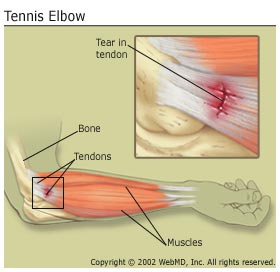|
| Tennis Elbow |
"Tennis elbow" is a common term for a condition caused by overuse of arm and forearm muscles that results in elbow pain. You don't have to play tennis to get this, but the term came into use because it can be a significant problem for some tennis players. Tennis elbow is caused by either abrupt or subtle injury of the muscle and tendon area around the outside of the elbow. Tennis elbow specifically involves the area where the muscles and tendons of the forearm attach to the outside bony area (called the lateral epicondyle) of the elbow. Your doctor may call this condition lateral epicondylitis. Another common term, "golfer's elbow," refers to the same process occurring on the inside of the elbow -- what your doctor may call medial epicondylitis. Overuse injury can also affect the back or posterior part of the elbow as well.
Tennis elbow most commonly affects people in their dominant arm (that is, a right-handed person would experience pain in the right arm), but it can also occur in the nondominant arm or both arms. What Are the Symptoms of Tennis Elbow?Symptoms of tennis elbow include:
Who Gets Tennis Elbow?Tennis elbow affects 1% to 3% of the population overall and as many as 50% of tennis players during their careers. Less than 5% of all tennis elbow diagnoses are related to actually playing tennis. Tennis elbow affects men more than women. It most often affects people between the ages of 30 and 50, although people of any age can be affected. Although tennis elbow commonly affects tennis players, it also affects other athletes and people who participate in leisure or work activities that require repetitive arm, elbow, and wrist movement. Examples include golfers, baseball players, bowlers, gardeners or landscapers, house or office cleaners (because of vacuuming, sweeping and scrubbing), carpenters, mechanics, and assembly-line workers. How Is Tennis Elbow Diagnosed?Tennis elbow cannot be diagnosed from blood tests and rarely by X-rays. Rather, it is usually diagnosed by the description of pain you provide to your doctor and certain findings from a physical examination. Since many other conditions can cause pain around the elbow, it is important that you see your doctor so the proper diagnosis can be made. Then your doctor can prescribe the appropriate treatment. Tennis elbow usually is successfully treated by medical means and only rarely requires surgery. The type of treatment prescribed for tennis elbow will depend on several factors, including age, type of other medications being taken, overall health, medical history, and severity of pain. The goals of treatment are to reduce pain or inflammation, promote healing, and decrease stress and abuse on the injured elbow. How Is Pain and Inflammation Reduced?To reduce the pan and inflammation of tennis elbow, try:
How Can I Promote Healing of My Tennis Elbow?This step begins a couple of weeks after the pain of tennis elbow has been reduced or eliminated. It involves specific physical-therapy exercises to stretch and strengthen muscles and tendons around the injured elbow. Any activity that aggravates the pain must be avoided. How Do I Decrease Stress and Abuse on Tennis Elbow?To help lessen the continued stress and abuse on tennis elbow:
What Is the Outlook for People With Tennis Elbow?Overall, 90% to 95% of people with tennis elbow will improve and recover with the treatment plan described. However, about 5% of people will not get better with conservative treatment and will need surgery to repair the injured muscle-tendon unit around the elbow. For 80% to 90% of people who have surgery, it results in pain relief and return of strength.
WebMD Medical Reference SOURCES: American Academy of Orthopaedic Surgeons. WebMD Feature: "Study Questions Support Bands for Tennis Elbow."
Reviewed by Marc C. Levesque, MD, PhD, MD on February 01, 2007
© 2009 WebMD, LLC. All rights reserved.
|
